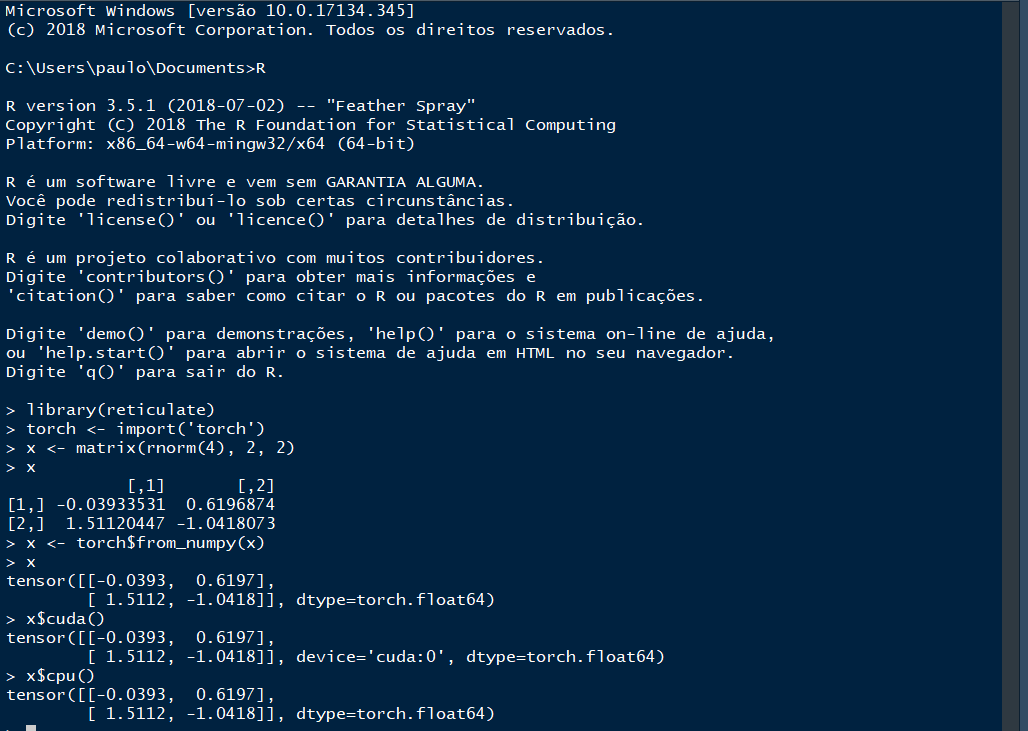Hi, everyone!
I was trying pytorch with gpu in R. The problem is: first, I tried direct in python and the follow code works:
import torch
dtype = torch.float
#device = torch.device("cpu")
device = torch.device("cuda:0") # Uncomment this to run on GPU
torch.randn(4, 4, device=device, dtype=dtype)
However, I got problems to run the same code in R with reticulate:
But, I got something more interesting. When a I did a reprex with this code, It simply worked:
library(reticulate)
torch <- import('torch')
np <- import('numpy')
device = torch$device("cuda:0")
torch$randn(c(4L), c(4L), device = device, dtype = torch$float)
#> tensor([[-0.5082, -0.0566, 0.3794, -0.6489],
#> [ 1.4504, 0.4627, 1.5426, -0.0883],
#> [ 0.4226, -0.7120, -0.7997, 0.1578],
#> [ 0.1594, 1.5402, 0.9680, -1.0612]], device='cuda:0')
torch$randn(c(4L), c(4L), device = device, dtype = torch$float)
#> tensor([[-0.2950, 1.3037, 0.6723, -1.9531],
#> [-0.7189, 0.4939, -0.0259, -0.0818],
#> [ 0.8678, -0.3601, -0.3294, -1.7991],
#> [ 0.8432, 0.1208, 0.7282, 1.3152]], device='cuda:0')
Created on 2018-10-20 by the reprex package (v0.2.1)
Any help for this? Thanks!
I'm using RStudio 1.2.97 and:
sessionInfo()
#> R version 3.5.1 (2018-07-02)
#> Platform: x86_64-w64-mingw32/x64 (64-bit)
#> Running under: Windows 10 x64 (build 17134)
#>
#> Matrix products: default
#>
#> locale:
#> [1] LC_COLLATE=Portuguese_Brazil.1252 LC_CTYPE=Portuguese_Brazil.1252
#> [3] LC_MONETARY=Portuguese_Brazil.1252 LC_NUMERIC=C
#> [5] LC_TIME=Portuguese_Brazil.1252
#>
#> attached base packages:
#> [1] stats graphics grDevices utils datasets methods base
#>
#> loaded via a namespace (and not attached):
#> [1] compiler_3.5.1 backports_1.1.2 magrittr_1.5 rprojroot_1.3-2
#> [5] tools_3.5.1 htmltools_0.3.6 yaml_2.2.0 Rcpp_0.12.18
#> [9] stringi_1.2.4 rmarkdown_1.10 knitr_1.20 stringr_1.3.1
#> [13] digest_0.6.16 evaluate_0.11
Created on 2018-10-20 by the reprex package (v0.2.1)

 ). It is less than 2 years old. But I complete agree with you it is probably an environment issue.
). It is less than 2 years old. But I complete agree with you it is probably an environment issue.